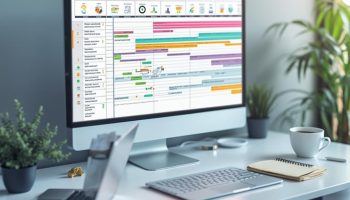Businesses such as accounting, consulting, and legal firms that generate money through billable services must arrange their operations effectively. But when resource planning tools and timesheet systems are used in isolation, it is impossible to verify that financial and project objectives are met, which is the case in most organizations today.
Timesheets provide a clear image at the end of each week or month of how many hours have been spent on a project and how much revenue has been generated as a result of those hours. It is impossible to determine whether or not the firm or its personnel are operating at peak efficiency even though these estimations are routinely compared to actual time and resources allocated to projects.
The management of the plan is equally as vital as creating the project in and of itself. It is critical to do plan-versus-actual analysis, also known as variance analysis, to improve corporate management. The tracking system keeps track of your progress and makes adjustments as needed based on the results.
What is plan vs. actual?
To put it another way, plan vs. actual is simply the process of actively reviewing and adjusting financial estimates in response to your existing economic outcomes. During this process, you’ll also be looking back on your behaviors from that period in order to contextualize your findings properly.
This is referred to as variance analysis, which is simply a different name for the same notion when it comes to accounting. It all boils down to contrasting what actually happened with what you anticipated would occur. Your strategy, tactics, critical numbers, and execution are all laid out in your plan.
Keeping track of progress and results allows you to see precisely what transpired. You can steer your organization with better, more direct management in order to deal with the discrepancy between plan and accurate results.
Why is it vital to use the method plan vs. actual?
To keep your projects on budget, you must understand who is having an impact on them. This goes from the employees who are performing the job to the clients for whom they are performing the work.
The new plan vs. Actual report allows you to understand how well your complex projects are. And retainers are progressing by comparing simple metrics such as the amount of time and money you’ve planned. And how much of that budget has been consumed.
When you are trying to recruit someone, you can wind up squandering a large sum of time as well as money. One of the most dangerous things you can do to your bottom line is to have too many people on the bench and not enough individuals.
The Planned vs. Actual report provides you with a wealth of valuable information regarding your team’s workload. Leaderboards display how much work each individual is completing, rather than how much work you expect them to achieve. You will be able to scale resources to fulfill the demands of your clients in this manner.
The Planned vs. Actual report provides you with precise, high-level figures. This will assist you in keeping track of your daily budgets and expenses.
These numbers are straightforward to read and comprehend. It also provides you with a great deal of information on the jobs, resources, and clients, allowing you to dig deep into your budgets with confidence.
There are filters for focusing on various sorts of work. And those for concentrating on individual projects and groups of tasks, among other filters. Exporting and processing data for your daily check-ins and weekly meetings can take a lot of time. So, the following strategies can help you save time in these situations.
Plan vs. Actual: What Should You Look For?
When it comes to comparing statistics, it is not enough to simply compare the data points. You must understand the context in which any gaps between your forecasts. And actual results occur in order to understand the importance of such differences.
Variance can be both negative and positive:
A positive variance is one in which you performed better than you anticipated. An increase in sales can measure success, units sold, a reduction in expenses, or an increase in cash flow, among other things.
Keep in mind that, depending on the statements you’re looking at. A positive variance may actually reflect optimal performance rather than an improvement in performance. In this case, the most obvious example is the reduction in costs.
Negative variance, which is the polar opposite of positive variance, arises when your actual results fall short of what you had anticipated. In the event of a decline in income, units sold, or cash flow, expenses may grow or lower, depending on the situation. You can think of positive variance in the same way you would think of negative variance. If you are looking at a financial statement that indicates a decrease in expenses.
The desire of your customer:
Undoubtedly, the most crucial thing you should be looking for is how much your clients enjoy what you’re producing. During this section, you can discuss, investigate, and establish a clear context for any deviations between your plan and what really happened.
This is not a straightforward numerical metric, and it is not specific to determine what it is. By beginning with certain objectives in mind when performing your study, it will be easier to comprehend how people are responding to your item or brand in the long run.
Has a fresh advertising campaign gotten underway for you? Did you lower your prices or offer a promotional discount? Perhaps you’ve developed an idea for a new product category or feature that you’d like to introduce.
Starting with what you did, modified, or adapted can give you a fair notion of how well you understand your target audience and how well you know yourself. By comparing your expectations with reality, you can determine how well you know each of them. It may also ensure that any successful strategies or negative results are dealt with as promptly as possible and assist you in adjusting your expectations for the future.
Another way of putting it is:
In case this text didn’t make it plain enough, it’s essential to conduct systematic comparisons of plans and reality. Making a single attempt and expecting good outcomes or a successful management approach is a waste of time. You’ll normally only do this monthly to enhance the precision of your projections, so schedule it accordingly.
Still, if your company is growing or in difficulties, it may be even more critical to do it more frequently. The use of equations in spreadsheets will make this review process more efficient and straightforward.
In addition, you will need to manually enter accounting information into the spreadsheets which you will do by hand, to complete the task. To get you started, there are templates for sales predictions and balance sheets. So that, you can download and use to create your own datasheets right immediately.






